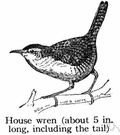BIRD SUET THISTLE BLACK OIL SUNFLOWER SEED CARDINAL * * BLACK-CAPPED CHICKADE * * CAROLINA CHICKADEE * * HOUSE FINCH * * PURPLE FINCH * * NORTHERN FLICKER * AMERICAN GOLDFINCH * * BLUE JAY * * DARK-EYED JUNCO * NUTHATCH * * PINE SISKIN * * WHITE-CROWNED SPARROW * HOUSE SPARROW * TUFTED TITMOUSE * * TOWHEE * DOWNY WOODPECKER * * HAIRY WOODPECKER * * RED-BELLIED WOODPECKE * * CAROLINA WREN * *
HOUSE WREN * *
Among them are mallard, great blue heron, rock pigeon, hummingbirds, woodpeckers, peregrine falcon, blue jay, American crow, tree and barn swallows,
house wren, bluebirds and robins, cedar waxwing, tanagers, northern cardinal and American goldfinch.
When we compare eastern bluebird occupancy at the study site with that of the
house wren, another secondary cavity nesting species, we find that while bluebirds were declining,
house wren numbers did not appear to change much over the ~ 20 y at this study site.
Nest boxes should be placed in open fields - not under trees - to avoid
house wren occupation.
A
house wren's song has structure, combining its elements into the distinctive, repeated patterns visible at right.
In spring, it may even
house wren or blackbird nests, as well as a host of hibernating creatures, including butterflies.
The most common nest box occupants detected were
House wren (n = 43), Bewick's wren (Thryomanes bewickii; n = 17), and wood duck (n = 10).
House Wren: Regular backyard visitors,
house wrens have diets that consist almost exclusively of insects and spiders.
Red-Winged Blackbird Ruby-Throated Hummingbird Scarlet Tanager Purple Martin
House Wren Indigo Bunting Cedar Waxwing Bluebird Bald Eagle Brown Pelican Turkey Herring Gull Mallard Duck Common Loon Canada Goose Great Blue Heron Red-Tailed Hawk Common Barn Owl Ring-Necked Pheasant Northern Bobwhite
Therefore, we tested the hypothesis that mites adversely affect the mass and survival of
House Wren nestlings.
We found that local bird species most frequently infested by ticks include the low-foraging grouse, turkey, chickadee,
house wren, gray catbird, brown thrasher, robin, wood thrush, hermit thrush, Swainson's thrush, veery, yellow warbler, ovenbird, northern waterthrush, Connecticut warbler, mourning warbler, common yellowthroat, goldfinch, rufous-sided towhee, field sparrow, white-throated sparrow, swamp sparrow and song sparrow.
Here we report a natural heterospecific cross-fostering experiment, which resulted from the usurpation of a
House Wren (Troglodytes aedon) nest, with two recently laid eggs, by a pair of Tree Swallows (Tachycineta bicolar).
 house wren - common American wren that nests around houses
house wren - common American wren that nests around houses